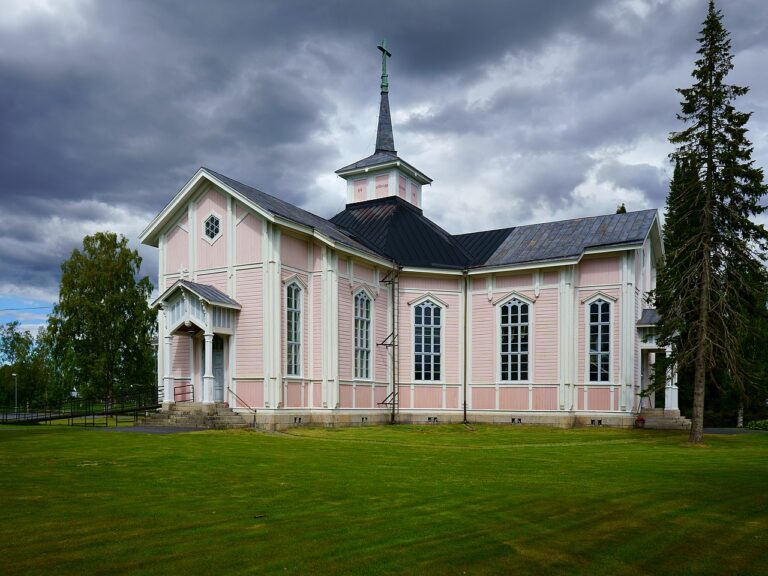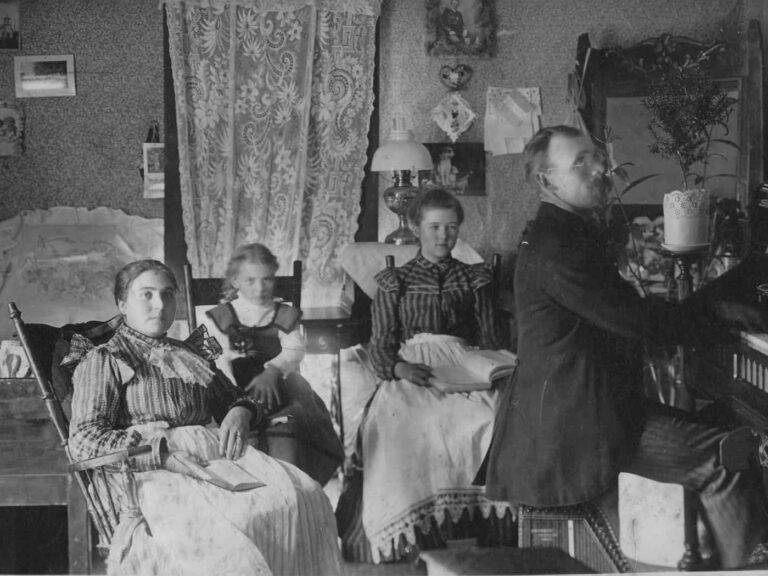By Rainer Långstedt, Spencer, NY.
Norden, 13 Aug. 2009.
Translated by June Pelo.
Albert Båsk, as of 2009, lived in Van Etten, New York. He said his life had always been diverse. His father John emigrated from Petalax as an 18-year-old in 1895. His mother was Emilia Sofia Sjöholm from Pedersöre. Albert’s mother’s mother died when his mother was four years old, and her father deserted the family. Emilia was moved from farm to farm. Her mother had a brother who lived in Escanaba, Michigan so she moved there when she was 17 years old. There she met John Båsk and married him. The couple’s first child was named Arvid. He was born on 23 Feb.1906. Then Albert was born. Later the family became homesick and traveled back to Petalax a few days before Midsummer 1908. They traveled via Hull, England and continued on the “Arcturus” to Finland.
“Finsk Amerikanaren” Lit a Longing for America
The family subscribed to the immigrant newspaper “Finska Amerikanaren” and that created a longing for America. John returned to Wisconsin where he found work at a sawmill. His wife and children remained at Hultholm in Petalax. Wife Emilia was pregnant and after John left for America her third child was born in October.
Albert and his brothers and mother lived with his father’s brother Kalle. He remembers this period as a miserable existence with daily hunger. There was no school in Hultholm, but Albert had learned to read by the time he was four years old. His mother moved to a place where she could find work and where the children could go to school. She arranged this in 1913 by purchasing a place of 18 hectares that was a few kilometers from the school. She probably bought it through a bank loan.
Johan Jakob Lindholm was then a teacher in Petalax. Albert has no good remembrances of his first teacher, who was a religious fanatic whose teaching method was based on forcing the children to learn everything by heart. When Lindholm was fired, he was succeeded by Valter Norrback who came from Sideby, and who had excellent modern teaching methods. To this day Albert gives thanks to him for leaving him with good memories.
His father came back to Petalax during the first world war in 1915 and became a farmer on the purchased farm. John hoped that one day he could return to America, but it became only a dream. The dream became true for two of his sons who were born in America; they emigrated to their birth country.
Revolution in Petalax
Albert was 13 years old when peace was declared. People were restless and worried. The Russians had a garrison in Petalax with a stable for 40 horses. The enlisted personnel were quartered with the horses but the officers had taken over the cantor’s house and lived there. Many of the soldiers were Balts and they had enough of the war and the Russian military. One of the soldiers was an Estonian who could speak Swedish. He persuaded the soldiers to give up their weapons. The soldiers later were transported to Vasa and then via St. Michel to Russia.
Drama in Petalax
Albert remembers that Kaarlo Wilenius, who was vicar in Petalax, had a son Lt. K. G. Wilenius who went to officer training in Fredrikshamn and later was in the Russian service as police chief in Jakobstad. On 7 Jan. someone knocked on the door of the parsonage and asked for the Lieutenant. When he answered the door he was shot dead by the unknown man. The murder was never solved, but a man known as Peltokangas was rumored to be involved. (The reason for the murder was thought to involve K. G. Wilenius’ activities as Jakobstad’s police chief where he persistently went after members of the resistance who took part in “the John Graften Affair” in 1905.) Otherwise, Petalax took a relatively small part in the War for Independence. The only one who died in battle was Artur Lillbacka who met death in the battle at Lempäälä. After the war there was famine and when he was 90 years old Albert still remembered how good bread tasted that was baked of graham flour that was sent from America and was paid for with a government loan.
Emigrant Albert
Albert came back to the United States in 1926 at age 22. He was born in Michigan so he visited the Consulate in Helsingfors to get his citizenship paper to travel to America as an American citizen. He took a train to Åbo, went by boat to Stockholm and by train to Göteborg. The liner “Drottningholm” sailed from Göteborg and then between the Shetland and Orkney islands. The ship first went to Canada where emigrants to Canada got off, and then the ship went to New York City. Albert did not go through Ellis Island because he came as an “American citizen.”
Albert’s older brother Arvid had come over a few years earlier and lived in his birthplace in Escanaba, Michigan where he had a job and earned 64¢ a day. His income was small but the brother managed and eventually bought a farm, and income was enough to train his son who became a professor in Denver, Colorado.
Albert Båsk, Carpenter
Albert was on the way to Escanaba but thought: “I am now in New York City, so I shall look at this big city.” He could live there with Kalle Stenbacka who had also emigrated from Petalax and lived in Brooklyn. Stenbacka knew a building contractor from Petalax who gave Albert a job. He worked 8 hours a day and got $5. The job lasted only four weeks. Eighty years later Albert wrote of his employer as: “He was a greedy son of a bitch.”
Later Albert worked for a Jew who owned a construction company and he paid Albert $8 a day. When Albert learned the basics of carpentry work, he was paid $12 a day. To begin with, Albert couldn’t speak English, so it was difficult to find a job, but he gradually learned English by reading the newspaper and through contact with his fellow workers.
Ville Ritola, Work Buddy
Another carpenter colleague Albert came to know in New York was Ville Ritola. Ritola had kept his Finnish citizenship. He held the world’s record for 10,000 meters and won 5 Olympic gold and 3 silver medals. Albert worked as a carpenter in New York City until 1943. For three years he worked on building the George Washington bridge. One time he worked for Donald Trump’s father’s father. Albert was not tall so he sought a specialty where skill is more important than strength.
Expert in Flooring
Albert began to do flooring, parquet floors, wooden floors, floors of all kinds. He hammered floors in the Empire State building for nine months. Albert said he was so skillful that he could do nearly flawless floors. When other workers became jobless during the depression, Albert was in such demand that he worked a lot of overtime. He regretted that he never went back to Escanaba. A visit to his brother had convinced Albert that the only ones who made money in Escanaba were saloons and whore houses. He is of the opinion that emigrants from northern Österbotten were more enterprising than southern Östrobothnians who drank more.
Albert Establishes a Family
Albert Båsk is not a communist, has never been a communist and has no plans to become a communist, but he found his wife in “The Finn Hall in Brooklyn” that was completely communist. He said that since he didn’t understand English and didn’t know of any Swedish Finn organization, he didn’t have many alternatives. Therefore the young man steered his steps to the “Haali”. There his eyes fell on a Finnish-speaking emigrant woman from Mariankylå in Pielavesi. She was Silvia Jaukiainen and she became his life’s companion. They married 3 Jan. 1935 and had two girls and a boy and many grandchildren and great grandchildren.
Albert in the War
During the second world war the United States built three military bases in Greenland. Albert knew a building contractor in New York City who sought Scandinavian workers who wanted to work in a cold climate. He was paid well and the contract provided steady work. In June 1943 Albert went to Greenland. He traveled in style – a big C54 transport plane flew the workers from Presque Isle in Maine to Greenland. Albert worked on barracks and a large hospital there were built for defense use.
In the fall of 1944 it was clear who would win the war, so the buildings in Greenland were closed and Albert came home to New York.
Several Jobs in Foreign Countries
In Greenland Albert was in contact with many workers who wanted to work in foreign lands. A work comrade asked him if he was interesting in going with him to South America. They would be well paid with a long-term contract, so in October 1947 they went to Venezuela and the Maracaibo Sea where they built an oil refinery for Shell. Shell had other work in the Netherland Antilles so Albert also worked in Aruba. He was scheduled to return to the United Sates in Dec. 1948. Raymond Concrete Pile was the name of the company where Albert worked in Venezuela. When he had been in New York for six months, they had a project in Monrovia, Liberia. There used to be little disturbances there, but their vice president was murdered there during the years Albert was in Liberia.
Home Sweet Home
During the 1950s Albert worked in the New York City area. In the beginning of the 1960s Albert and Silvia began planning to leave Brooklyn. The children were grown and had moved away. Their neighborhood was taken over by a criminal element from Puerto Rico. They bought a 147 acre farm in idyllic Spencer, New York. Albert worked for several years for a business in Ithaca, NY. Silvia died in 1979 and Albert was alone. He managed by himself very well. He moved to a private home that was built for older and handicapped people.
Still Going Strong
Albert was capable of cooking his own food. He still walked three miles a day as a 90-year-old and helped shovel snow. He’s sorry his Swedish now became rusty. He lived in a place where there were several Swedish-speaking people. He ascribed his long life to exercise, wholesome diet that included buttermilk, and sober habits. One can describe Albert with a slogan for Johnny Walker whisky “103 years old and still going strong.”
Additional comments from June Pelo: Albert Båsk was thought to be the oldest living Swedish Finn in the US, but my (June’s) cousin Lorena Spring Volz was born Oct 9, 1905, in Oscoda, Michigan, and was 4 months older than Albert, so she was considered the oldest living Swede Finn in the US unless someone makes a claim.





